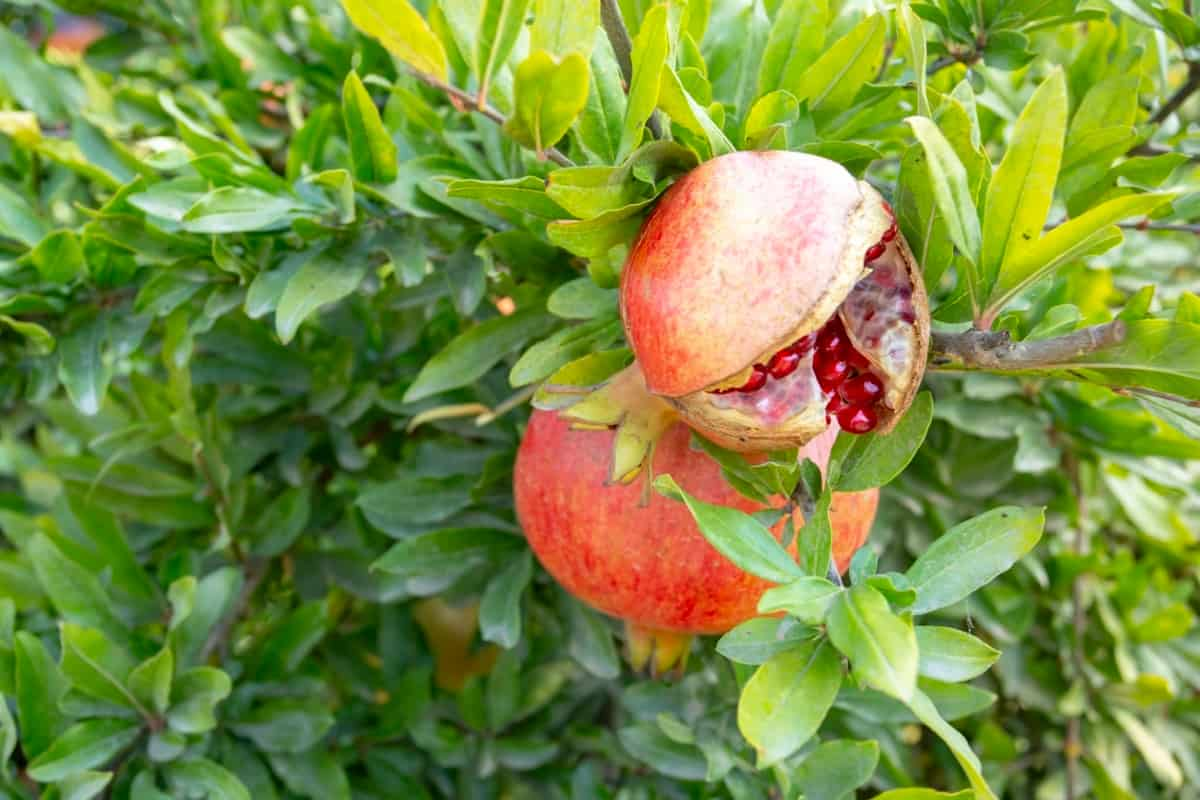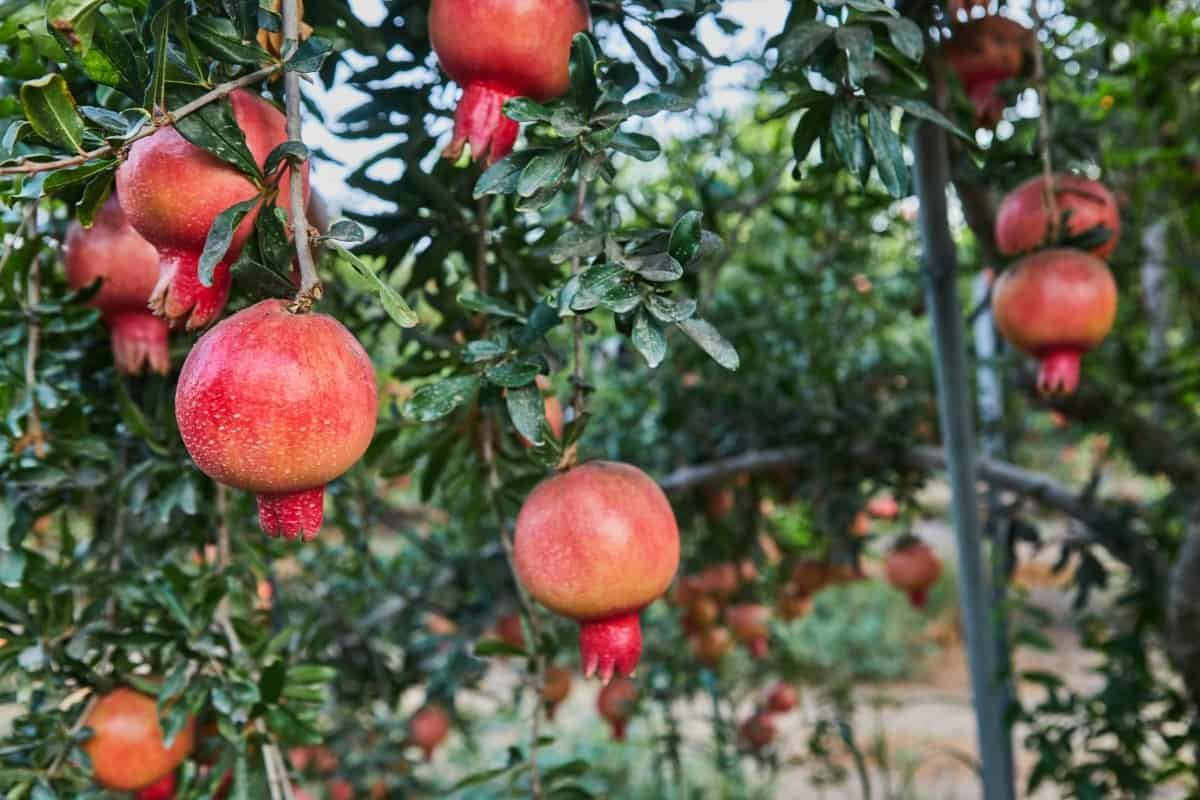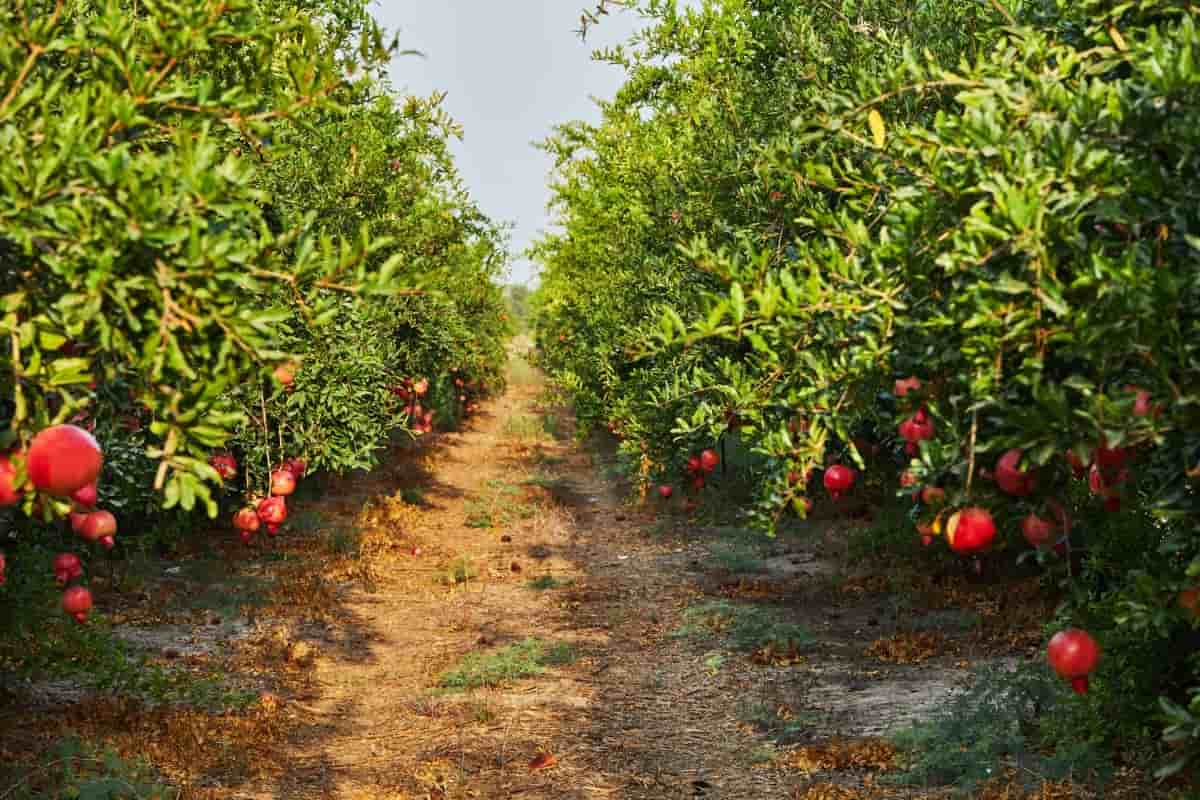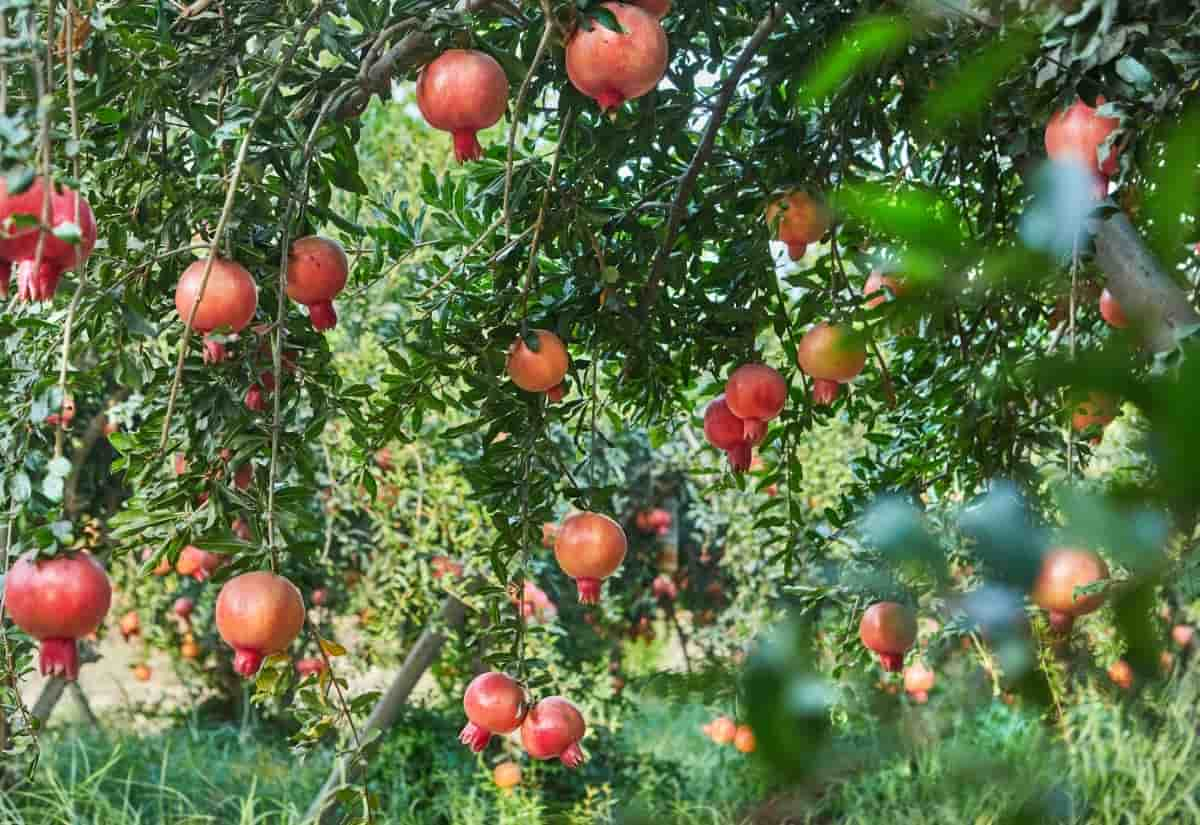The Pomegranate (Punica granatum) is a fruit-bearing deciduous shrub in the family Lythraceae. The fruit development stage of Pomegranate farming is a crucial period that determines the quality and yield of the harvest. Issues like splitting, browning of arils, nutrient deficiencies, water stress, sunscald damage, and mechanical injuries can hinder optimal fruit development. Farmers must be vigilant and proactive in addressing these challenges to their harvest.

Splitting of Pomegranate Fruits
The common issue that Pomegranate farmers may encounter during the fruit development stage is the splitting of Pomegranate fruits. This phenomenon can be quite disheartening for growers as it affects both the appearance and quality of the fruit.
Splitting usually occurs when there are significant fluctuations in irrigation or rainfall, causing rapid changes in fruit size and internal pressure. As a result, the outer skin of the Pomegranate cannot keep up with this sudden growth, leading to cracks or splits on the surface. To prevent this problem, farmers must maintain consistent watering practices throughout the growing season.
Pomegranate Aril Browning
The arils are the juicy seed coverings that make Pomegranates so visually appealing and delicious. However, when they start to brown prematurely, it not only affects the fruit’s market value but also indicates underlying problems. Several factors can contribute to aril browning, including improper handling post-harvest, storage conditions, or even certain diseases affecting the Pomegranate tree itself. To prevent this issue, proper harvesting techniques and immediate cooling of the fruits are crucial steps in maintaining their freshness and color.
Inadequate Pollination and Its Effects
Inadequate pollination is a crucial issue during the fruit development stage of Pomegranate farming. When there are not enough bees or other pollinators around, Pomegranate flowers may not get properly fertilized. As a result, fewer seeds will develop inside the fruit, leading to smaller and misshapen Pomegranates.
In case you missed it: 10 Reasons Why Pomegranate Tree is Not Blooming and Fruiting: Remedies and Treatment

The effects of inadequate pollination can be seen in the final quality and yield of the fruits. Pomegranates with poor seed development may have less juice content and lower sweetness levels. This impacts both the taste and market value of the crop. To address this issue, farmers can introduce bee colonies to their orchards or utilize techniques like hand pollination to ensure proper flower fertilization.
Pest Attacks on Developing Fruits
These small invaders can wreak havoc on the delicate fruit, causing damage and reducing yield. Common pests that target Pomegranates include aphids, thrips, and fruit flies. They feed on the fruit’s flesh or sap, leading to deformities and discoloration. To combat these pesky creatures, farmers often resort to integrated pest management strategies.
This approach involves using natural predators like ladybugs or releasing beneficial insects to control pest populations without harmful chemicals. Additionally, maintaining good orchard hygiene by removing fallen fruits can help reduce pest breeding grounds. Regular monitoring of the orchard is essential to detect early signs of pest infestation.
Fungal Diseases Affecting Fruit Quality
Fungal diseases can significantly impact the quality of Pomegranate fruits during their development stage. These diseases are caused by various fungi that thrive in humid and warm conditions, affecting the fruit’s appearance and taste. One common fungal disease is anthracnose, which causes dark lesions on the fruit surface. This not only affects the visual appeal but also leads to rotting, reducing shelf life.
Another culprit is powdery mildew, a white powdery substance that forms on the fruit skin. It weakens the fruit structure and can result in deformities or premature dropping. Botrytis cinerea, known as gray mold, can cause fuzzy gray patches on Pomegranates. This fungus spreads rapidly in moist environments and compromises fruit integrity. To combat these fungal diseases, farmers must implement proper sanitation practices and apply fungicides at recommended intervals to protect their precious Pomegranate harvest from deterioration.
Nutrient Deficiencies Impacting Fruit Growth
Nutrient deficiencies can impact the growth and development of Pomegranate fruits on your farm. Without essential nutrients, such as nitrogen, phosphorus, and potassium, and micronutrients like iron and zinc, the fruit quality may suffer. This deficiency can manifest in various ways, from stunted fruit size to poor coloration.
In case you missed it: How to Control Pomegranate Pests Naturally: How to Get Rid of Them with Natural and Organic Treatment

To ensure optimal fruit growth, it is crucial to test the soil pH levels and nutrient content regularly. Adjusting fertilizer applications based on these results can help prevent deficiencies before they affect your harvest. Additionally, maintaining a balanced nutrient supply throughout the growing season is key to supporting healthy fruit development.
Water Stress: Over-Irrigation and Under-Irrigation
Water stress, whether from over-irrigation or under-irrigation, can significantly impact Pomegranate fruit development. Over-irrigation may lead to waterlogging in the soil, causing root suffocation and reducing nutrient uptake. On the other hand, under-irrigation can result in dehydration of the plant, leading to stunted growth and smaller fruits.
Finding the right balance is important for optimal fruit production. Proper drainage should be in place to avoid water accumulation around the roots. Adequate watering during critical growth stages ensures healthy fruit development without succumbing to water stress-related problems that could affect overall yield and quality.
Sunscald and Heat Damage to Fruits
Sunscald and heat damage can be a real threat to Pomegranate fruits during their development stage. When exposed to intense sunlight, the outer skin of the fruit can become discolored and develop sunburn patches. This not only affects the appearance but also compromises the overall quality of the fruit.
To prevent sunscald, Pomegranate trees must be adequately shaded, especially during peak sun hours. Consider using shade cloth or planting companion plants that offer natural protection from direct sunlight. Watch for early signs of sunscald or heat damage and take prompt action. By protecting your Pomegranate fruits from excessive heat exposure, you can ensure a higher yield and better-quality harvest at the end of the season.
Mechanical Damage During Fruit Development
Mechanical damage can occur for various reasons, such as improper handling or accidental impact. These damages not only affect the fruit’s visual appeal but also make it more susceptible to rot and decay. To prevent mechanical damage during fruit development, farmers should handle the fruits with care and avoid rough handling practices.
In case you missed it: How to Control Pomegranate Pests Naturally: How to Get Rid of Them with Natural and Organic Treatment

Additionally, implementing protective measures such as using padding materials in harvesting containers can help reduce the risk of damage. By being mindful of potential sources of mechanical damage and taking steps to mitigate them, Pomegranate farmers can ensure better quality fruits for harvest.
Management of Fruit Cracking
Fruit cracking can be a common issue in Pomegranate farming during the development stage. It occurs when the fruit rapidly absorbs water, causing the skin to split. One way to prevent fruit cracking is by providing a balanced irrigation schedule that meets the plant’s needs without overwatering. Mulching around the plant base can help regulate soil moisture levels, reducing stress on developing fruits.
It’s also essential to monitor weather conditions closely and adjust irrigation practices accordingly. By maintaining a stable environment for Pomegranate trees, farmers can minimize the risk of fruit cracking and promote healthy fruit development. With proper care throughout the growing season, Pomegranate farmers can optimize their yields and produce high-quality fruits for market or personal consumption.
- Beneficial Insects in Pest Management
- Natural Solutions for Pest Control in Flower Gardens
- Types of Fungicides Used in Agriculture
- Common Issues in the Fruit Development Stage of Pomegranate Farming
- Fruit Development Issues in Papaya: Easy Solutions and Treatment
- Soil-Borne Diseases and How to Protect Your Plants
- Practices to Prevent Disease Spread in the Garden
- From Wilted to Thriving: How to Treat Root Rot Naturally in Houseplants
- Natural Remedies to Cure Brown Spots on Fig Tree Leaves